
Thelymitra crinita, commonly known as the blue lady orchid, the queen orchid, the lily orchid, is a species of orchid which is endemic to the south-west of Western Australia. It has a single broad, oval leaf and up to fifteen brilliant blue flowers with a blue column with the lobe on top of the anther covered with short, finger-like calli.
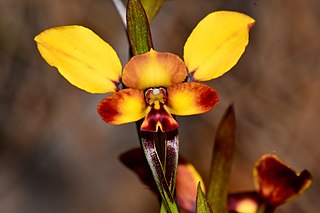
Diuris porrifolia, commonly called the small-flowered donkey orchid is a species of orchid which is endemic to the south-west of Western Australia. It has two or three leaves and up to seven yellow flowers with brown or reddish markings. It is similar to the common donkey orchid but its flowers are smaller and it has a more easterly distribution.
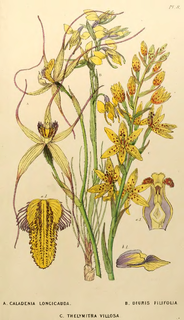
Diuris filifolia, commonly known as the cat's face orchid, is a species of orchid which is endemic to the south-west of Western Australia. It is one of the rarest Diuris in Western Australia, sometimes flowering in large numbers but only after hot summer fires.

Thelymitra macrophylla, commonly called the large-leafed sun orchid or scented sun orchid, is a species of flowering plant in the orchid family Orchidaceae, and is endemic to the south-west of Western Australia. It has a single thick, broad, leathery leaf and up to twenty five relatively large dark blue to purplish flowers with white, toothbrush-like tufts.

Pterostylis barbata, commonly known as the western bearded greenhood or bird orchid is a species of orchid endemic to the south-west of Western Australia. Flowering plants have a rosette of leaves at the base of the plant and a single translucent white flower with dark green veins on a flowering stem with up to 20 stem leaves. It is one of a number of bearded orchids, some of which have yet to be formally described, all of which have a distinctive feather-like labellum.
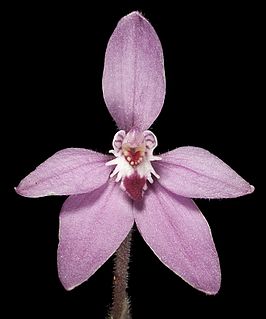
Caladenia reptans subsp. reptans, commonly known as the little pink fairy or dwarf pink fairy, is a plant in the orchid family Orchidaceae and is endemic to the south-west of Western Australia. It has a single hairy leaf and up to three relatively small, pink flowers which have a labellum with three distinct lobes.
Caladenia reptans subsp. impensa, commonly known as the pale pink fairy, is a plant in the orchid family Orchidaceae and is endemic to the south-west of Western Australia. It has a single hairy leaf and up to three pale pink flowers which have a labellum with three distinct lobes. It is similar to subspecies reptans except that its leaf is green on both sides and the flowers are larger and on a taller flowering spike.

Thelymitra graminea, commonly called the shy sun orchid, is a species of orchid in the family Orchidaceae and is endemic to the south-west of Western Australia. It has a single leathery, channelled leaf and up to ten relatively small blue, self-pollinating flowers with white, toothbrush-like tufts on the top of the anther.

Thelymitra granitora, commonly called the coastal granite sun orchid or coastal sun orchid, is a species of orchid in the family Orchidaceae and is endemic to the south-west of Western Australia. It has a single short, curved and channelled dark green leaf and up to eight relatively large pale blue or white, self-pollinating flowers with white mop-like tufts on the top of the anther.
Thelymitra vulgaris, commonly called the slender sun orchid or common sun orchid, is a species of orchid in the family Orchidaceae and endemic to the south-west of Western Australia. It has a single erect, dark green leaf and up to nine relatively small, blue to purplish or white flowers.
Thelymitra xanthotricha, commonly called the yellow tufted sun orchid or yellow tufted slender sun orchid, is a species of orchid in the family Orchidaceae and endemic to the south-west of Western Australia. It has a single erect, fleshy, channelled, dark green leaf and up to six relatively large dark blue to purplish flowers.
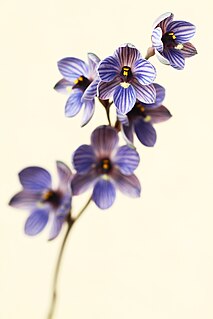
Thelymitra campanulata, commonly called the bell sun orchid or shirt orchid, is a species of orchid in the family Orchidaceae and is endemic to the south-west of Western Australia. It is a common species with a single narrow leaf and up to fifteen distinctly cup-shaped, prominently striped blue or mauve flowers with crowded, finger-like glands on top of the anther.
Thelymitra cornicina, commonly called the lilac sun orchid, is a species of orchid in the family Orchidaceae and is endemic to the south-west of Western Australia. It has a single narrow, pale green leaf and up to eight lilac-tinged blue flowers with the lobe on top of the anther covered with short, finger-like calli.
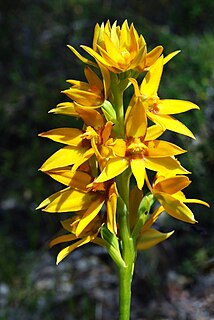
Thelymitra dedmaniarum, commonly called the cinnamon sun orchid, is a species of orchid in the family Orchidaceae and is endemic to Western Australia. It has a single flat, leathery leaf and up to fifteen cinnamon scented, golden yellow flowers. It is a rare orchid with a restricted distribution.
Thelymitra fuscolutea, commonly called the chestnut sun orchid, is a species of orchid in the family Orchidaceae and is endemic to the south-west of Western Australia. It has a single erect, flat, leathery leaf and up to fifteen or more yellowish green flowers with reddish brown streaks and blotches. The column has broad, deeply fringed cream or whitish wings.

Thelymitra magnifica, commonly called the Crystal Brook sun orchid, is a species of orchid in the family Orchidaceae and is endemic to a small area in the south-west of Western Australia. It has a single erect, flat, leathery leaf and up to eight crowded, dark golden brown flowers with yellow streaks and blotches. The column has broad, deeply fringed, yellow or brownish wings.
Thelymitra stellata, commonly called the star orchid or starry sun orchid, is a species of orchid in the family Orchidaceae and is endemic to the south-west of Western Australia. It has a single erect, flat, leathery leaf and up to twelve brown to reddish brown flowers with yellow streaks and blotches. The column has broad, deeply fringed, orange or yellow wings.
Thelymitra spiralis, commonly called curly locks, is a species of orchid in the family Orchidaceae and endemic to the south-west of Western Australia. It has a single erect leaf, spiralling around the flowering stem and up to three pink, reddish, purplish or blue flowers with two large yellow or orange ear-like arms on the sides of the column.
Thelymitra variegata, commonly called the Queen of Sheba, is a species of orchid in the family Orchidaceae and endemic to the south-west of Western Australia. It has a single erect, spiral, dark green leaf with a purplish base and up to five glossy, variegated reddish, purplish or violet flowers with darker spots and blotches and yellowish margins. There are two bright yellow or orange arms on the sides of the column.

Thelymitra petrophila, commonly known as the granite sun orchid, is a species of orchid that is endemic to Western Australia. It has a single erect, channelled, long light green leaf and up to ten or more pale blue to mauve or pink flowers. It grows in drier area, usually in shallow soil pockets on granite outcrops.












